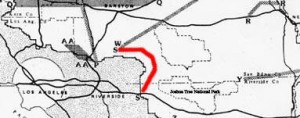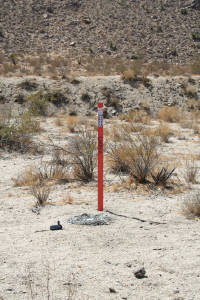Rep. Kalin and Sen. Olseen push LS Power tax exemption
April 28th, 2009
Well, Jeremy Kalin is not happy with me, but I don’t see that amendments to the Tax Omnibus bill does it. He says that all the local governments are covered in a Tax Omnibus amendment (Tax Omnibus is HF 2323, HERE) and that they must have a Host Fee Agreement. But what I see is one amendment that is GOOD language I’ve been passing out since 2005, except for one serious problem — where I had “Host Fee Agreement” it says “site agreement.” Color me a lawyer, but that’s not the same thing. Here’s that amendment, 272.0275 below. If it said “Host Fee Agreement” or “Agreement for payment in lieu of taxes” I’d be over the moon with joy, but this could mean anything and does not address payment of taxes. What do you think?
103.6 Sec. 6. [272.0275] PERSONAL PROPERTY USED TO GENERATE
103.7 ELECTRICITY; EXEMPTION.
103.8 Subdivision 1. New plant construction after January 1, 2010. For a new
103.9 generating plant built and placed in service after January 1, 2010, its personal property
103.10 used to generate electric power is exempt if an exemption of generation personal property
103.11 form, with an attached siting agreement, is filed with the Department of Revenue. The
103.12 form must be signed by the utility, and the county and the city or town where the facility is
103.13 proposed to be located.
103.14 Subd. 2. Definition; applicability. For purposes of this section, “personal property”
103.15 means tools, implements, and machinery of the generating plant. The exemption under this
103.16 section does not apply to transformers, transmission lines, distribution lines, or any other
103.17 tools, implements, and machinery that are part of an electric substation, wherever located.
103.18 EFFECTIVE DATE.This section is effective the day following final enactment.
The language they put in that’s LS Power specific does offer protections, but given there are three lines into the Chisago sub, and a new one just announced going east into Wisconsin, I don’t see that any limitation of transmission routing would be effective.
Here’s the LS Power specific language, one sentence is now two (para.5 & 6), and there’s an added paragraph that it must be in a county with an essential services and transmission services ordinance (geeee, I wonder who helped write that?). A signed “development agreement” does not address personal property taxes. So I’m not satisfied (I know, always the bitch, but there it is, this isn’t enough, doesn’t have the right language).
1.29 Sec. 5. Minnesota Statutes 2008, section 272.02, is amended by adding a subdivision
101.30to read:
101.31 Subd. 92. Electric generation facility; personal property. (a) Notwithstanding
101.32subdivision 9, clause (a), attached machinery and other personal property that is part of
102.1an electric generation facility that exceeds 150 megawatts of installed capacity, does
102.2not exceed 780 megawatts of summer capacity, and that meets the requirements of this
102.3subdivision, is exempt. At the start of construction, the facility must:
102.4(1) be designed to utilize natural gas as a primary fuel;
102.5(2) be owned by an entity other than a public utility as defined in section 216B.02,
102.6subdivision 4;
102.7(3) be located within five miles of two or more interstate natural gas pipelines;
102.8(4) be located within one mile of an existing electrical transmission substation with
102.9operating alternating current voltages of 115 kV, 345 kV, and 500 kV;
102.10(5) be designed to provide electrical capacity, energy, and ancillary services;
102.11(6) have satisfied all of the requirements under section 216B.243;
102.12(7) have executed an interconnection agreement with the Midwest Independent
102.13System Operator that does not require the acquisition of more than one mile of new
102.14electric transmission right-of-way within the county where the facility is located, and does
102.15not provide for any other new routes or corridors for future electric transmission lines in
102.16the county where the facility is located;
102.17(8) be located in a county with an essential services and transmission services
102.18ordinance;
102.19(9) have signed a development agreement with the county board in the county in
102.20which the facility is located. The development agreement must be adopted by a two-thirds
102.21vote of the county board, and must contain provisions ensuring that:
102.22(i) the facility is designed to use effluent from a wastewater treatment facility as its
102.23preferred water source and will not seek an exemption from legislative approval under
102.24section 103G.265, subdivision 3, paragraph (b);
102.25(ii) all processed wastewater discharge will be colocated with the outfall of a
102.26wastewater treatment facility; and
102.27(iii) penalties will be paid to the county for harm to any aquifer or surface water as a
102.28result of construction or operation and maintenance of the facility; and
102.29(10) have signed a development agreement with the township board in the township
102.30in which the facility is located containing provisions ensuring that noise and visual
102.31impacts of the facility are fully mitigated. The development agreement must be adopted
102.32by a two-thirds vote of the township board.
102.33(b) Construction of the facility must begin after March 1, 2010, and before March 1,
102.342014. Property eligible for this exemption does not include electric transmission lines and
102.35interconnections or gas pipelines and interconnections appurtenant to the facility.
103.1(c) The exemption granted under this subdivision is void if the Public Utilities
103.2Commission issues a route permit for an electric transmission line connected to the
103.3electric substation nearest the exempt facility on a route where no electric transmission
103.4line currently exists.
103.5EFFECTIVE DATE.This section is effective the day following final enactment.
===================================
Why do elected officials do things like this? Who are they representing? Why would they give away a source of much needed local revenue for local governments? Why would they do that without any kicker for the affected local governments making the sacrifice of hosting a HUGE electric generating facility? Why would they put a for-profit independent power producer above their constituents? Why would they let a corporation off the hook, at the same time that millions of taxpayers are lined up at the mailbox? What makes this corporation special?
LOCAL GOVERNMENT APPROVAL???
H-O-S-T F-E-E A-G-R-E-E-M-E-N-T ???
Is it that difficult?
Did they bother to look at Minn. Stat. 272.02 to see how exemptions are done?
Yes, there’s a new power plant planned for Chisago County, and
Rep. Jeremy Kalin and Sen. Rick Olseen, joined by Rep. Rob Eastlund and Rep. Bob Dettmer, have introduced a bill to exempt LS Power’s 855MW gas plant from utility personal property taxes. And by this bill, they’re screwing their constituents. How? There’s no requirement in the bill that the local governments (Chisago County, Lent Township and the school district) approve this exemption AND there’s no requirement in the bill that there be a Host Fee Agreement.
Here’s the bill, SF 1671 and HF 2317:
1.1 A bill for an act1.2 relating to taxation; providing a personal property exemption for an electric
1.3 generation facility;amending Minnesota Statutes 2008, section 272.02, by
1.4 adding a subdivision.
1.5 BE IT ENACTED BY THE LEGISLATURE OF THE STATE OF MINNESOTA:
1.6 Section 1. Minnesota Statutes 2008, section 272.02, is amended by adding a
1.7 subdivision to read:
1.8 Subd. 90. Electric generation facility; personal property. Notwithstanding
1.9 subdivision 9, clause (a), attached machinery and other personal property which is part
1.10 of an electric generation facility that exceeds 150 megawatts of installed capacity, does
1.11 not exceed 780 megawatts of summer capacity, and that meets the requirements of this
1.12 subdivision is exempt. At the time of construction, the facility must:
1.13 (1) be designed to utilize natural gas as a primary fuel;
1.14 (2) not be owned by a public utility as defined in section 216B.02, subdivision 4;
1.15 (3) be located within five miles of at least two interstate natural gas pipelines;
1.16 (4) be located within one mile of an existing electrical transmission substation with
1.17 operating alternating current voltages including each of 115 kV, 345kV, and 500 kV;
1.18 (5) be designed to provide electrical capacity, energy, and ancillary services and have
1.19 satisfied all of the requirements under section 216B.243; and
1.20 (6) have executed an interconnection agreement with the Midwest Independent
1.21 System Operator that does not require the acquisition of more than one mile of new
1.22 electric transmission right-of-way within the county where the property is located.
1.23 Construction of the facility must be commenced after March 1, 2010, and before
1.24 March 1, 2014. Property eligible for this exemption does not include electric transmission
2.1 lines and interconnections or gas pipelines and interconnections appurtenant to the
2.2 property or the facility.
2.3 EFFECTIVE DATE.This section is effective for assessment year 2009 and
2.4 thereafter, for taxes payable in 2010 and thereafter.
As someone said today, “They’re telling us that all the plants get exemptions.” To which I said, “Yes, and are they telling you that most also require that local governments approve it, and that they get a Host Fee Agreement?” And of course, the answer was: NO! Local governments need to know that there is an option that they’re not being told about, and an option that would provide serious financial benefits at a time when local governments are really hurting.
Where to go for guidance? Look no further than language found in other exemptions, in Minn. Stat. 272.02:
Jeremy, Rick, add this language, quick before you take away revenue that they sorely need:
To qualify for an exemption under this subdivision, the owner of the electric generation facility must have an agreement with the host county, township or city, and school district, for payment in lieu of personal property taxes to the host county, township or city, and school district.
Or from the Cannon Falls Invenergy gas plant:
To qualify under this subdivision, an agreement must be negotiated between the municipal power agency and the host city, for a payment in lieu of property taxes to the host city.
This is something we learned in Goodhue County, dealing with the Prairie Island nuclear generating plant, these are for-profit independent power producers, and they have to pay their fair share. If they’re exempted, there must be a requirement that they pay their fair share to the county, township and school district to compensate them for hosting the plant.
Here’s a memo from Goodhue County’s former Auditor, Brad Johnson, who is now the head financial honch at the School District, still hot on the trail of that utility personal property tax:
Brad Johnson letter – Invenergy Peaking Plant, Goodhue County
Here’s a Resolution from Scott County showing how to do it, how to stand up on your hinders when faced with a corporation with its slimy hand out, or rather, its slimy hand in your pants pocket (hand in your pants, perhaps?):
OK, Chisago County, Lent Township, and the school district, it’s YOUR turn. Rep. Kalin and Sen. Olseen, it’s YOUR turn. Step up to the plate, stand up for your constituents!
Meanwhile, I’ll keep looking for those Goodhue County and Scott County Host Fee Agreements.
Mesaba spinnin’ it against gravity
April 2nd, 2009
THE MESABA PROJECT IS DEAD, DEAD, DEAD! Coal gasification is not happening. IGCC ist zu ende! How many silver stakes through its slimy heart will it take?
Once more with feeling:
This is from Charlotte Neigh, Co-Chair of Citizens Against the Mesaba Project, who, having reviewed the recent spin-doctoring of Excelsior Energy, and their tentacle-reach toward Minnesota Municipal Utilities — they’re trying to make it look like they’ve got something they haven’t got:
It is not correct to say that the federal government would back 73 percent of the total cost, or that the federal government has “pledged” $800 million in loan guarantees, or that municipal utilities would have to raise only 27 percent of the project costs to secure ownership of Unit 1 of the Mesaba Project.
Excelsior Energy has not yet been awarded any loan guarantees. It is one of eleven final applicants to share in a pool of $4 billion. Excelsior admits that its negotiations with DOE will continue throughout 2009. DOE stated in October 2007 that projects relying upon a smaller guarantee percentage will be given greater weight. Despite this statement, Excelsior repeatedly misled the media and even the PUC about the status of the loan guarantees, suggesting that they would cover 80 percent of the project costs.
Apparently Excelsior is now seeking 73 percent but this is a long way from becoming reality. A key requirement for qualifying is to have an assurance of revenues to be generated from sale of the product. This means a long-term commitment from a customer to purchase the energy. This is why the failure to achieve a PPA with Xcel Energy is critical. Other obstacles are DOE requirements for: credit assessment without a loan guarantee; approval of environmental and other permits; reduced greenhouse gases; and relative amount of cash contributed by the principals.
Now Excelsior is trying to entice municipal utilities into purchasing ownership interests by suggesting that 100 percent ownership can be obtained by raising 27 percent of the costs. Municipal utilities should carefully assess the likelihood that this amount or any loan guarantees at all will be awarded for the Mesaba Project before issuing bonds to finance such a purchase.
More information and analysis about the federal loan guarantees can be found by scrolling down to the October 8, 2007 entry on the CAMP website: www.camp-site.info/
Charlotte Neigh, Co-Chair
Citizens Against the Mesaba Project
Here’s an example of the bogus spin, from Business North — note she can’t even get the announcement time-frame right… Excelsior announced Mesaba in December, 2001, that’s EIGHT years ago:
No customer for controversial energy project
Excelsior Energy targets municipal PUCs in search for a buyer as key May 1 deadline looms.
4/1/2009
by Beth BilyAbout six years ago in the wake of the permanent closing of LTV Steel Mining in Hoyt Lakes, momentum began to develop behind a project concept, one since celebrated and renounced.
That proposed Mesaba Energy project with a price estimated at $2 billion has moved through various phases of public review to a potentially new location further west. Along the way it has become one of the most vigorously debated economic development initiatives proposed for Minnesota’s Iron Range.
Meanwhile, an important deadline looms that could make or break the project. The Minnesota Public Utilities Commission had ordered talks between Mesaba’s parent, Excelsior Energy, and power giant, Twin Cities-based Xcel Energy. The two sides were directed to negotiate a Power Purchase Agreement (PPA) for the approximate 600 megawatts of electricity Mesaba’s proposed Unit One would produce. That ordered negotiation period ends on May 1 and there is no evidence an agreement will be reached.
Kandiyohi burner shot down twice yesterday!
February 18th, 2009
Kandiyohi Development is at it again, trying to ram through an incinerator in Rockford, Minnesota. Here’s a prior post:
Apparently, their plans to site in in the City of Rockford crashed, so they went to the neighboring township. Yesterday, they went down in flames in both Rockford Township and Wright County where they’re trying to locate this thing — both local governments, on hearing their pitch to be exempted from utility personal property taxes and asking for their blessing, said NO! We’re not signing off on a utility personal property tax exemption!
The School Board is next…
Here’s the bill that they’re trying to get through the legislature, SF 703 and HF 845 that needs to be stopped pronto:
1.8 Subd. 90. Biomass electrical generation facility; personal property.
1.9 Notwithstanding subdivision 9, paragraph (a), attached machinery and other personal
1.10 property which is part of an electrical generation facility that meets the requirements of
1.11 this subdivision is exempt. At the time of construction, the facility must:
1.12 (1) have a generation capacity of less than 30 megawatts;
1.13 (2) be located within a township with a population of less than 7,000;
1.14 (3) be located on land within five miles of a distribution substation;
1.15 (4) be designed to utilize biomass as a primary fuel source;
1.16 (5) be owned by a limited liability company, limited liability partnership or
1.17 corporation, any of which must be registered in Minnesota; and
1.18 (6) have received by resolution the approval of the governing body of the county,
1.19 township, and school board in which the proposed facility is to be located for the
1.20 exemption of personal property under this subdivision.
1.21 Construction of the facility must be commenced before January 1, 2013. Property
1.22 eligible for this exemption does not include electric transmission lines and interconnections
1.23 or gas pipelines and interconnections appurtenant to the property or the facility.
1.24 EFFECTIVE DATE.This section is effective the day following final enactment.
Who to contact about this? It’s been sent to the House Tax Committee and the Senate Energy Committee, so start there.
Authors to blame for this are: Senators Koch, Dibble and Dille, and Representatives Emmer, Dill and Rukavina.
Click here to contact them:
Call and email them today!
You’d think that Dill and Rukavina would have learned with that Laurentian biomass burner that violated its permit and had to be shut down, the MPCA had to rework the permit so that it could even run, and it has been having so many problems and is out of service so often that the ratepayers are FURIOUS!
Here’s the language we added to the Mesaba bill, now Minn. Stat. 272.02, Subd. 55, to require “payment in lieu of taxes” which would tank the project:
I think this is the one for the Invenergy plant in Cannon Falls, Minn. Stat. 272.02, Subd. 69:
LA billboard: NO TRANSMISSION LINE!
February 18th, 2009
I-10 billboard criticizes LA proposal to run electrical lines through Inland areas
By JANET ZIMMERMAN
The Press-EnterpriseThe billboard reads: “L.A. Mayor Antonio Villaraigosa, It’s not yours to destroy!”
Check out the site for the:
And here’s the map of LA’s preferred corridor, and the wide line on the map is accurate as they’re planning a TWO to FIVE mile wide corridor! Really! TWO to FIVE miles!
Here’s another site — groups fighting this stupid “Green Path North” idea:
STOP Green Path North, LADWP and Imperial Irrigation District
Putting the screws to coal
February 4th, 2009
Here’s the Executive Order — let’s have one in every state:
EXECUTIVE DIRECTIVE No. 2009 – 2
3. Generating or purchasing electricity from existing electricity generating resources.
This Directive is effective immediately.
Given under my hand this 3rd day of February in the year of our Lord, two thousand and nine.





